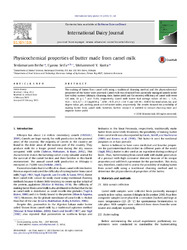| dc.contributor.author | Berhe, Tesfamariam | |
| dc.contributor.author | Seifu, Eyassu | |
| dc.contributor.author | Kurtu, Mohammed Y. | |
| dc.date.accessioned | 2019-03-19T13:58:39Z | |
| dc.date.accessioned | 2021-03-15T09:24:11Z | |
| dc.date.available | 2019-03-19T13:58:39Z | |
| dc.date.available | 2021-03-15T09:24:11Z | |
| dc.date.issued | 2013 | |
| dc.identifier.citation | Berhe, T., Seifu, E., & Kurtu, M. Y. (2013). Physicochemical properties of butter made from camel milk. International Dairy Journal, 31(2), 51-54. | en_US |
| dc.identifier.issn | 1879-0143 | |
| dc.identifier.uri | https://www.sciencedirect.com/science/article/pii/S0958694613000447 | |
| dc.identifier.uri | http://moodle.buan.ac.bw:80/handle/123456789/152 | |
| dc.description.abstract | The making of butter from camel milk using a traditional churning method and the physicochemical properties of the butter were assessed. Camel milk was obtained from pastorally managed camels in the Erer valley, eastern Ethiopia. Churning time, butter yield and fat recovery efficiency of camel milk were 120 min, 43 g L−1 and 79.8%, respectively. Camel milk butter had average values of 64.1 ± 5.2%, 55.8 ± 1.6%, 6.7 ± 2.5 mg KOH g−1, 4.90 ± 0.15, 43.2 ± 0.8 °C and 1.4530 ± 0.0002 for total solids, fat, acid degree value, pH, melting point and refractive index, respectively. The results showed the possibility of making butter from camel milk; however, further research is needed to reduce churning time and improve butter yield. | en_US |
| dc.language.iso | en | en_US |
| dc.publisher | Elservier | en_US |
| dc.subject | Physicochemical properties | en_US |
| dc.subject | Butter | en_US |
| dc.subject | Camel milk | en_US |
| dc.title | Physicochemical properties of butter made from camel milk | en_US |
| dc.type | Article | en_US |

